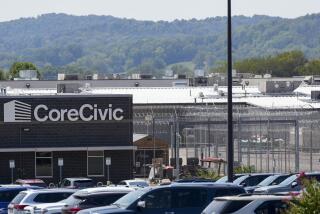SOUTHERN CALIFORNIA ENTERPRISE : Parent of Addiction Treatment Centers Faces Serious Ailments of Its Own
- Share via
Frawley Corp., which claims its Schick tobacco, alcohol and drug addiction treatment centers have restored thousands of patients to productive lives, is itself ailing. Its chance of recovery is dubious.
The Encino-based company has been forced into a tailspin, primarily by the push among health insurers to reduce costs. Exacerbating a five-year decline in revenue generated by its operating unit has been the collapse in Southern California real estate, which is among Frawley’s principal holdings.
Frawley’s losses since 1988--its last profitable year--total $12.8 million. At the end of last year, revenue had declined more than 72%.
And, in the opinion of its auditors, Deloitte & Touche of Los Angeles, there is “doubt about (Frawley’s) ability to continue as a going concern,” according to an April filing with the Securities and Exchange Commission.
About 70% of the company’s stock (it was delisted by the Pacific Stock Exchange in 1982 after tumbling to six cents a share) is owned by Patrick J. Frawley Jr., its eccentric chief executive, and his family. His son Michael P. Frawley is vice president of the corporation.
Patrick Frawley says he will pull his company out of its hole by selling off real estate, jettisoning two of Schick’s three addiction treatment hospitals, and putting smaller Schick units in acute care hospitals across the country.
Frawley, 71, a millionaire who once chaired the Schick Safety Razor Co., may have the wherewithal to succeed, but the odds are long. As of March 31, the company owed $4 million in current liabilities--due within 12 months--and its current assets had shrunk to $2 million. For the quarter that ended March 31, Frawley lost $689,000 on revenue of $1.82 million.
“I think they’re trying as hard as they possibly can to turn things around,” said Frank Hawrylak, an analyst with Tweedy, Browne Company, a New York investment firm that held about 7% of Frawley’s stock before unloading it earlier this year. “Frawley believes he’s got a good product,” Hawrylak said. “I don’t know if he does or not.”
The company’s core business has always been its Schick Laboratories unit, which has a handful of small addiction treatment centers and, until recently, large addiction treatment hospitals in Santa Barbara, Seattle and Ft. Worth, Tex. Schick treats addictions by administering small electric shocks or drugs that induce nausea while patients are confronted with the substances they are addicted to. Patrick Frawley says Schick has a 70% success rate in treating alcohol and tobacco addictions, and a 50% success rate treating addictions to cocaine and other drugs.
Schick thrived in the 1980s before health insurers noted that mental health treatments were the fastest rising area of health care costs.
The growing clout of cost-conscious health maintenance organizations accelerated the trend toward a sharp reduction in mental health payments.
In the past decade, the money HMOs have budgeted for mental health coverage, including addiction treatment, has dwindled from $2 per patient per month to about 50 cents, said John Edelston, president of HealthPro Associates, a consulting firm in Woodland Hills.
Much of the cost savings has been achieved by curtailing inpatient care in favor of cheaper outpatient treatment. Schick has bucked this trend; it still requires patients to check in for a 10-day stay, followed by a pair of two-day treatment sessions. Patrick Frawley insists that changing the Schick method would reduce its effectiveness.
As a result, Schick’s price of about $12,000 for treatment is more than twice the cost for typical outpatient treatments at other detox centers.
Schick’s high prices have made it difficult for the company to land contracts with HMOs.
Having become increasingly dependent on patients who pay out of pocket for treatment, and facing more competition from nicotine patch treatments and other alternative products, Schick’s business has shrunk. The company treated about 2,000 addicts in 1988, and Patrick Frawley acknowledged the number “has gone down steadily” ever since.
Frawley Corp. has managed to stay afloat largely by selling off Southern California real estate that it had purchased with 1980s profits from the Schick division. By 1989, the company owned 713 acres of largely undeveloped land in the Santa Monica Mountains near Agoura that it had acquired for about $12.9 million, according to SEC documents.
Over the past three years, Patrick Frawley said, the company sold 450 acres in the Santa Monica mountains and suffered a $3-million loss.
Frawley and his son Michael have also lent the company $416,000, according to SEC documents.
That Patrick Frawley has dipped into his own pockets reflects his obsessive commitment to the business. For the elder Frawley, a former alcoholic, curing the nation’s addicts has become a personal crusade.
When he was treated for alcoholism in the early 1970s, Patrick Frawley had had a successful career operating businesses and investing in real estate since the 1940s. Early in his career, he took over a failing ballpoint pen parts maker that became the Papermate Pen Co. and later chaired the Schick razor company.
Frawley launched Schick treatment centers in 1972 after he was impressed with the treatment for alcoholism that he received at the Shadel Hospital in Seattle. He eventually bought the facility.
Fighting addictions became his life’s mission, and often he seems able to talk about little else.
During a series of lengthy telephone interviews, Frawley expounded on the personal and social costs of addictions. Asked to discuss the condition of his business, Frawley repeatedly resisted. “You’re not interested in the guts of it--saving people’s lives,” he said.
Sketching his plan to save the company, Frawley said the first step is to “get rid of the bricks and mortar.” So the company shut down its 50-bed detox hospital in Ft. Worth in May, and Frawley said the building was expected to be sold this month for $1.6 million.
The 30-bed Santa Barbara hospital was closed in June, and Frawley hopes to sell it for about $2.5 million, he said. The proceeds from the hospital sales will be used to pay off debts, he said.
The hospitals will be replaced by a network of smaller treatment centers within acute care hospitals across the country, Frawley said. One such unit, a 13-bed facility at St. Mary Medical Center in Long Beach, opened in November. Four others could be in place by the end of the year, Frawley said, though he declined to give more details.
Frawley hopes the Schick unit can cut its costs by sharing administrative, clerical and maintenance costs with hospitals. And hospitals, Frawley said, will welcome the business because the trend to outpatient care has left many hospitals with empty beds.
“We’re trying to lower costs as much as we can,” Frawley said. “I think we’re going to be successful eventually.”
But with revenues on a steep five-year slide, the escape hatch for Frawley Corp. grows narrower by the minute. That is a problem even the chief executive acknowledges.
“Obviously we can’t do it much longer,” Frawley said. “We’ve got to come up with some solutions.”
More to Read
Inside the business of entertainment
The Wide Shot brings you news, analysis and insights on everything from streaming wars to production — and what it all means for the future.
You may occasionally receive promotional content from the Los Angeles Times.










